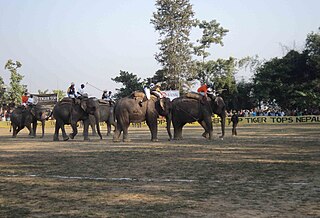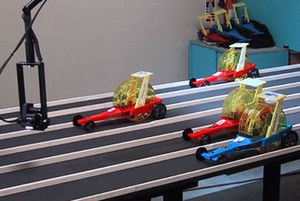 W
WAnimals in sport are a specific form of working animals. Many animals, at least in more commercial sports, are highly trained. Two of the most common animals in sport are horses and dogs.
 W
WAlligator wrestling is an attraction, that later evolved into a sport, that began as hunting expeditions by Native Americans. It has been described as "alligator capturing techniques."
 W
WThe Château de Beaucens, is a 14th-century ruined castle in the commune of Beaucens in the Hautes-Pyrénées département of France. The site has been transformed into a zoological park, the "Donjon des Aigles", where one may admire birds of prey in flight around the ruins of the castle, with a view over the vallée des Gaves.
 W
WA blood sport or bloodsport is a category of sport or entertainment that involves bloodshed. Common examples of the former include combat sports such as cockfighting and dog fighting and some forms of hunting and fishing. Activities characterized as blood sports, but involving only human participants, include the Ancient Roman gladiatorial games.
 W
WBovine sports are sports that involve cattle, commonly a bull, ox, steer, cow or calf.
 W
WBull wrestling, cow fighting or bull fighting is a non-lethal bloodsport between bulls or cows found in some parts of the world.
 W
WCamel wrestling is a sport in which two male Tülü camels wrestle, typically in response to a female camel in heat being led before them. It is most common in the Aegean region of Turkey, but is also practiced in other parts of the Middle East and South Asia.
 W
WCat agility is a sport in which trained cats are lured through timed obstacle courses by their handlers.
 W
WElephant polo is a variant of polo played while riding elephants. It is played in Nepal, Rajasthan (India), and Thailand. England and Scotland regularly field teams. Equipment consists of a standard polo ball and six to ten foot cane sticks with a polo mallet head on the end. The pitch is three-quarters of the length of a standard polo pitch, due to the lower speed of the elephants. Two people ride each elephant; the elephants are steered by mahouts, while the player tells the mahout which way to go and hits the ball.
 W
WFerret-legging was an endurance test or stunt in which ferrets were trapped in trousers worn by a participant. Also known as put 'em down and ferret-down-trousers, it seems to have been popular among coal miners in Yorkshire, England. Contestants put live ferrets inside their trousers; the winner is the one who is the last to release the animals.
 W
WHamster racing is a sport in which hamsters are placed in hamster wheels or hamster balls – often fitted to miniature racing vehicles – and raced down a straight 9 meter (30 ft) course. The hamster crossing the finish line in the shortest amount of time wins. According to a 2001 media report, the world-record time for this course setup is 38 seconds.
 W
WThe true messenger pigeon is a variety of domestic pigeons derived from the wild rock dove, selectively bred for its ability to find its way home over extremely long distances. The rock dove has an innate homing ability, meaning that it will generally return to its nest using magnetoreception. Flights as long as 1,800 km have been recorded by birds in competitive pigeon racing. Their average flying speed over moderate 965 km distances is around 97 km/h and speeds of up to 160 km/h have been observed in top racers for short distances.
 W
WA horse archer is a cavalryman armed with a bow and able to shoot while riding from horseback. Archery has occasionally been used from the backs of other riding animals. In large open areas, it was a highly successful technique for hunting, for protecting the herds, and for war. It was a defining characteristic of the Eurasian nomads during antiquity and the medieval period, as well as the Iranian peoples, and Indians in antiquity, and by the Hungarians, Mongols, Chinese, and the Turkic peoples during the Middle Ages. By the expansion of these peoples, the practice also spread to Eastern Europe, Mesopotamia, and East Asia. In East Asia, horse archery came to be particularly honored in the samurai tradition of Japan, where horse archery is called Yabusame.
 W
WRabbit show jumping, also known as rabbit agility or rabbit hopping, is modeled after horse show jumping. It is typically conducted in a closed, indoor arena, with obstacles scaled to suit the rabbits. Competitions have been held in the United States and several European countries.
 W
WRam fighting is a blood sport between two rams, held in a ring or open field. It is commonly found in sheep or goat husbandry culture in Africa, Asia and Europe. In Nigeria, Uzbekistan and Indonesia, ram fighting gains popularity among locals. Although categorized as a blood sport and an act of animal cruelty, ram fights rarely resulted in the death of the defeated ram, as the loser often is allowed to flee the arena.
 W
WRat agility is a sport for pet rats. It basically uses scaled down versions of the obstacles used for dog agility. The sport originated in Sweden and can trace its origin back to table runs in the 1980s. It became an official competition in 2000.
 W
WA robot jockey is commonly used in camel racing as a replacement for human jockeys. Developed in 2004, the robotic jockeys are slowly phasing out the use of human jockeys, which in the case of camel racing in Saudi Arabia, Bahrain, United Arab Emirates, and Qatar, often employs small children who reportedly suffer repeated systemic human rights abuses. In response to international condemnation of such abuses, the nations of Qatar and the UAE have banned the use of human jockeys in favor of robots.
 W
WSquirrel fishing is the sporting practice of "catching" squirrels and attempting to lift them into the air using a nut tied to a string or fishing line, and optionally some kind of fishing pole.
 W
WSteer riding is a rodeo youth event that is an introductory form of bull riding for younger riders, usually between the ages of seven and fourteen. Instead of bucking bulls, the children ride steers that buck. Steers are used because they are known to have a less volatile temperament than bulls and many breeds weigh less than bulls, which makes them a perfect stepping stone to junior bulls. The steers usually weigh between 500 to 1,000 pounds. Steer riding usually follows mutton busting and calf riding as the participant ages and grows. Many young and aspiring bull riders who train in steer riding compete in the National Junior Bullriders Association.
 W
WVinkensport is a competitive animal sport in which male common chaffinches are made to compete for the highest number of bird calls in an hour. Also called vinkenzetting. It is primarily active in Flanders, the Dutch-speaking region of Belgium.
 W
WYak polo is a Mongolian variant of the sport polo. It is played on yaks instead of on horseback.